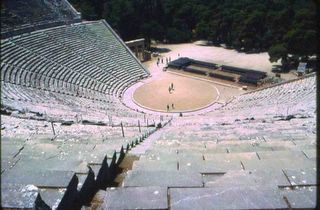
(To blog readers: My son is traveling to Greece in April with a group from Massachusetts’ Oliver Ames [OA] High School [see March 5 post]. To give students and parents a glimpse of some of the places on the group’s itinerary and to provide links to sites the travelers may find helpful, I’m devoting 10 consecutive daily posts from March 22 through March 31 to places on the kids’ Greek itinerary. [I can’t think of a better place than Greece to hang, really or virtually, but if you’d like to go elsewhere, cruise the archives to visit scores of other great places, from Jamaica to Jordan, Malta to Mexico.] Wherever you end up, Kalo taxidi! Have a good trip.)
“MAPMAPMA.” Signs for it are everywhere, fenced yards overflow with stacks of it, and trucks filled with slabs of it ply the pine-covered mountain roads that rise from the coast near Nafplio and meander to the incomparable theater at Epidauros. "Marmara. " Marble. We found ourselves behind lumbering marble trucks many times as we made our way up to Epidauros, and on one particularly long ascent, when we weren’t going anywhere any faster than the groaning marble-filled flatbed in front of us, I used the time to contemplate this splendid stone. Nature’s gift to people in hot places. Something about this rock makes it stay cool when the world around it blisters and burns. On a searing day in Greece, park yourself on a slab of marble and feel its chill go to work, soaking into your being and ratcheting your body temperature down a few degrees. Run your palms across its magnificent smoothness. Even a raw unsculpted slab is a thing of beauty. Eternal, strong, majestic.
Like the exquisite theater at Epidauros. Carved into one mountain and facing another, both the setting and structure send a shiver of awe through your bones. Timeless, powerful, perfect.
And its perfection is its hallmark. At the base of the theater’s 56 semi-circular stone rows of seats, which accommodate 14,000, lies the orchestra, a flat area where the chorus sang and danced. In the orchestra’s center is the base of an altar. On this spot, you can test the mathematical, scientific and architectural abilities of one Polyclitus the Younger.
Epidauros is generally attributed to Polyclitus, and scholars consider Epidauros the most perfect example of ancient theatrical architecture. Polyclitus used intricate mathematical formulas to mesh the audience’s sight lines with crystal clear acoustics. The theater is not completely concentric with the circular stage and orchestra area because his quest for visual and audible perfection led Polyclitus to nudge this and that a degree or two here and there. Imagine him walking the job, asking, “Can you hear me now?” to workmen 30, 40, 60, 70 feet below, adjusting cuts in the mountainside and repositioning stone seats, aisles and actors’ spaces to deliver maximum enjoyment to theatergoers. "People will be coming to see gory Greek tragedies, men, and I want them to have a good time!"
The result of Polyclitus’ pursuit of the perfect visual and acoustical experience is that average Joes in the cheap seats see and hear almost as well as those sitting front and center. At Epidauros, even the nosebleed seats at the top of the house are good seats – very good seats. Even up there, you can hear the whisper of an actor or the rustle of sheet music.
Grab a friend. Stand on the altar base in the middle of the orchestra. Send your friend to the 56th row, some 75 feet up the mountainside from the orchestra. When you ask, “Can you hear me now?” and your friend waves, nods or shouts in the affirmative, know that Polyclitus is smiling. A life’s work well done. Bravo, Polyclitus. Take a bow.
Comments or questions? Email me.
www.LoriHein.com
